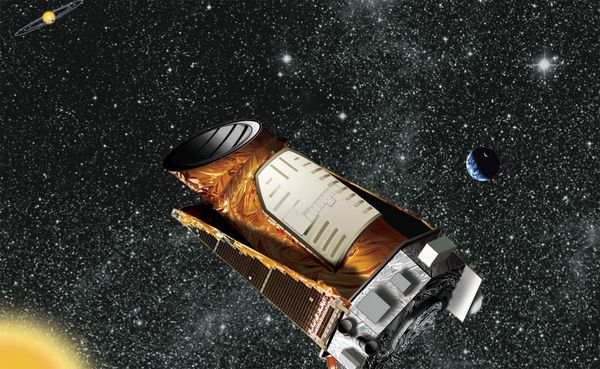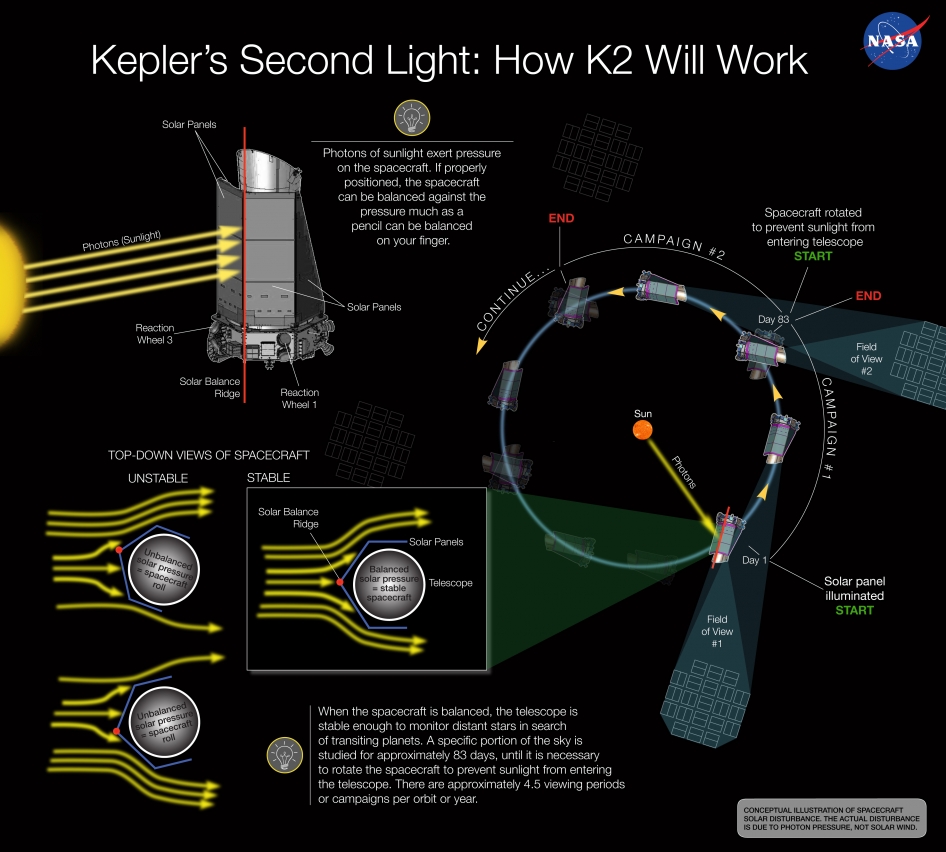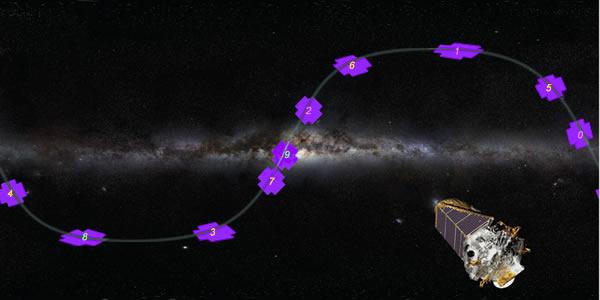K2: Kepler's Second Light
I think everyone who is even slightly interested in astronautics knows that the most successful project to search for exoplanets of the Kepler space telescope some time ago began technical problems. In this, in general, there is nothing surprising, because the satellite has already exceeded the plan of its work: designed for three and a half years, it worked more than 4 years without any problems.

"Kepler" through the eyes of the artist. (Credit: NASA / Kepler mission / Wendy Stenzel)
NASA, however, did not abandon the device, as was the case, for example, with the recently transmitted ISEE-3 satellite enthusiasts . Instead, a way was found to continue the satellite operation in a slightly modified mode. So, Kepler will continue to delight fans and specialists with new discoveries, but now as a K2 project.
Let me first remind you how Kepler worked initially.
The work of Kepler on the detection of exoplanets is based on the method of transit photometry. The essence of the method is very simple. If a remote star has a planet, and during its rotation this planet passes through the star's disk, then the visible brightness of the star will periodically decrease by a small amount depending on the diameter of the planet and the radius of its orbit.
A simple animation that demonstrates the essence of the transit method. (Credit: NASA Kepler Mission / Dana Berry)
')
Such darkening can be registered by a rather sensitive photometer. The equipment installed on Kepler has a sensitivity of 20 ppm (parts per million) for a sun-type star of the 12th apparent magnitude when observed for 6.5 hours. For comparison, the natural fluctuations in the brightness of the Sun are about 10 ppm, the central transit of the Earth causes a darkening at 80 ppm and lasts about 13 hours.
The field covered by the Kepler camera is 105 square degrees. It hit more than 100,000 stars of the desired brightness, for which it was necessary to conduct continuous monitoring. After all, an eclipse for a planet of the terrestrial type usually lasts only a few hours, and it happens about once a year, and for confident detection of a planet it is necessary to record a darkening three or four times.

The field of view of Kepler. (Credit: NASA / Ames / JPL-Caltech)
It is for these reasons that Kepler always looked at the same point in the sky (lying outside the ecliptic, so that the Sun would not interfere with observations). Stabilization of the telescope in one direction was achieved at the expense of four gyroscopes, one of which broke on July 12, 2012 - 4 months before the end of the main phase of the mission. In principle, three gyroscopes were enough to stabilize the device in space, but when the second of them broke in May 2013, the mission, in fact, came to an end. The two remaining for reliable stabilization of the device was not enough.
NASA engineers, however, having broken their heads a little and having collected various proposals received for them, found an elegant way to extend the life of a useful tool. Since the two gyroscopes are, after all, intact, they can be used further, they thought, but it is required to find something third that would add rigidity to fixing the telescope. And so the third was the sun.
The most amazing thing is how exactly the sun will fix the device. It is supposed to use ... the light pressure that the photons emitted by the Sun have on the satellite! Yes, of course, this pressure is not very great, but other forces in outer space are small, so it should be enough to equalize Kepler with our star.

Infographics how K2 will work. (Credit: NASA Ames / W Stenzel) In high resolution.
The problem, however, is that for reliable stabilization of the device must be oriented almost parallel to the plane of the ecliptic. This means that the Sun will periodically fall into the field of view of the telescope and disable it. Therefore, the project of the second life of Kepler, called K2, will observe not one point of the sky, but nine, changing them every 83 days - periodically turning away from the Sun, as it were.

The location of the nine K2 observation areas in the sky. (Credit: ESO / S. Brunier / NASA Kepler Mission)
During the K2 mission, which will last 4 years, about 100,000 stars will be promoted. Of course, the detection efficiency of exoplanets will decrease due to the worsened stabilization, and because it will be impossible to observe the same star continuously, but despite this, scientists hope to get new data on exoplanets. First of all, we are talking about observation of colder stars than the Sun, in whose systems potentially inhabited planets rotate in smaller orbits and complete a complete revolution in less time.
In addition to exoplanets, the K2 project will also observe bright galaxies and supernovae.
The proposed approach has already been tested on the device, and was approved by NASA in May. And on May 30, the mission officially began collecting scientific data. The first results, apparently, should be expected by the beginning of next year, so we will wait.

"Kepler" through the eyes of the artist. (Credit: NASA / Kepler mission / Wendy Stenzel)
NASA, however, did not abandon the device, as was the case, for example, with the recently transmitted ISEE-3 satellite enthusiasts . Instead, a way was found to continue the satellite operation in a slightly modified mode. So, Kepler will continue to delight fans and specialists with new discoveries, but now as a K2 project.
How did Kepler work?
Let me first remind you how Kepler worked initially.
The work of Kepler on the detection of exoplanets is based on the method of transit photometry. The essence of the method is very simple. If a remote star has a planet, and during its rotation this planet passes through the star's disk, then the visible brightness of the star will periodically decrease by a small amount depending on the diameter of the planet and the radius of its orbit.
A simple animation that demonstrates the essence of the transit method. (Credit: NASA Kepler Mission / Dana Berry)
')
Such darkening can be registered by a rather sensitive photometer. The equipment installed on Kepler has a sensitivity of 20 ppm (parts per million) for a sun-type star of the 12th apparent magnitude when observed for 6.5 hours. For comparison, the natural fluctuations in the brightness of the Sun are about 10 ppm, the central transit of the Earth causes a darkening at 80 ppm and lasts about 13 hours.
The field covered by the Kepler camera is 105 square degrees. It hit more than 100,000 stars of the desired brightness, for which it was necessary to conduct continuous monitoring. After all, an eclipse for a planet of the terrestrial type usually lasts only a few hours, and it happens about once a year, and for confident detection of a planet it is necessary to record a darkening three or four times.

The field of view of Kepler. (Credit: NASA / Ames / JPL-Caltech)
It is for these reasons that Kepler always looked at the same point in the sky (lying outside the ecliptic, so that the Sun would not interfere with observations). Stabilization of the telescope in one direction was achieved at the expense of four gyroscopes, one of which broke on July 12, 2012 - 4 months before the end of the main phase of the mission. In principle, three gyroscopes were enough to stabilize the device in space, but when the second of them broke in May 2013, the mission, in fact, came to an end. The two remaining for reliable stabilization of the device was not enough.
K2 - use the sun!
NASA engineers, however, having broken their heads a little and having collected various proposals received for them, found an elegant way to extend the life of a useful tool. Since the two gyroscopes are, after all, intact, they can be used further, they thought, but it is required to find something third that would add rigidity to fixing the telescope. And so the third was the sun.
The most amazing thing is how exactly the sun will fix the device. It is supposed to use ... the light pressure that the photons emitted by the Sun have on the satellite! Yes, of course, this pressure is not very great, but other forces in outer space are small, so it should be enough to equalize Kepler with our star.

Infographics how K2 will work. (Credit: NASA Ames / W Stenzel) In high resolution.
The problem, however, is that for reliable stabilization of the device must be oriented almost parallel to the plane of the ecliptic. This means that the Sun will periodically fall into the field of view of the telescope and disable it. Therefore, the project of the second life of Kepler, called K2, will observe not one point of the sky, but nine, changing them every 83 days - periodically turning away from the Sun, as it were.

The location of the nine K2 observation areas in the sky. (Credit: ESO / S. Brunier / NASA Kepler Mission)
During the K2 mission, which will last 4 years, about 100,000 stars will be promoted. Of course, the detection efficiency of exoplanets will decrease due to the worsened stabilization, and because it will be impossible to observe the same star continuously, but despite this, scientists hope to get new data on exoplanets. First of all, we are talking about observation of colder stars than the Sun, in whose systems potentially inhabited planets rotate in smaller orbits and complete a complete revolution in less time.
In addition to exoplanets, the K2 project will also observe bright galaxies and supernovae.
The proposed approach has already been tested on the device, and was approved by NASA in May. And on May 30, the mission officially began collecting scientific data. The first results, apparently, should be expected by the beginning of next year, so we will wait.
Some sources used
- Planet-hunting Kepler telescope back in action - SPACEFLIGHT NOW
- A Sunny Outlook for NASA Kepler's Second Light - NASA
- Kepler's Second Light: How K2 Will Work - NASA
- Kepler Mission Manager Update: K2 spacecraft operations continue - NASA
- Kepler Mission Manager Update: K2 Has Been Approved! - NASA
- Kepler (Telescope) - Wikipedia
- Kepler (spacecraft) - Wikipedia
Source: https://habr.com/ru/post/225705/
All Articles